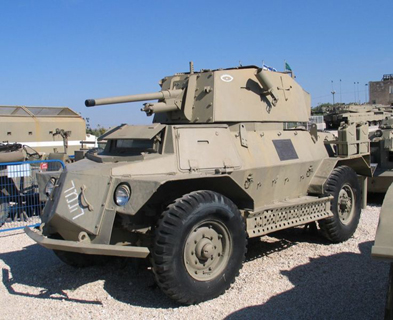Ari Shavit's Lydda Massacre | |
Israeli wrongdoing, whether real or imagined, holds a special fascination for certain media outlets, which seem to get a particular thrill from putting Israel under the microscope. Writing about genuine bloodletting in other parts of the world just isn't as much fun as indicting Israelis for supposed massacres, and thereby once again putting Zionism – and therefore the Jews – on trial.
Which brings us to the latest in this genre, "Lydda, 1948" (The New Yorker,
October 21, 2013) written by the well-known and talented Israeli
journalist Ari Shavit. In Shavit’s very deceptive and even contradictory
recounting, Israeli soldiers led by a certain Lt. Col. Moshe Dayan, and
armed with:
joined other Israeli forces attacking Lydda (and its
neighbor Ramle) during Israel's War of Independence. Led by Dayan's
marauding forces the Israelis took control of "key positions" in the
town, but the next day fighting flared again, and:
Is this really what happened? Well let's start with
the matter of the "giant armored vehicle," a phrase which could only
stun anyone the least bit familiar with Israeli military history. It was
actually just a lightly armored scout car – with regular inflated
rubber tires – standing about seven feet high and just six feet wide.
Here's a picture of the actual vehicle, at the Israeli Armored Corps
Museum at Latrun:

To put this in perspective, that's about the size of a Ford Expedition SUV (the Expedition is slightly shorter at 77 inches high, but wider at almost 80 inches across):

The armored car, known as a Marmon-Herrington,
and made in South Africa, was used by Allied forces in WW2, mostly as a
reconnaissance car, and a number of them were given to the Arab Legion
(as Jordan's army is known) by their British allies after the war.
The one in question was abandoned by Jordanian forces
when it overturned in a ditch. Spotting it, and knowing that possessing
this one vehicle would be a major upgrade to his lightly-equipped
battalion, Dayan and a volunteer braved sniper fire to get a cable on
the car, right it and tow it out of the ditch. The Israeli soldiers
nicknamed the thing the "Terrible Tiger" and after a few hours practice
with the car immediately put it to use in their attack on the garrison
towns of Lydda and Ramle.
Though outnumbered by the town's defenders, Dayan and his men used speed and surprise to subdue the town, which surrendered.
The overall commander of the operation in Lydda,
Moshe Kelman, met with the town's leaders to discuss surrender terms,
beginning with Simon Garfeh, the Greek Orthodox Archimandrite of Lydda.
Garfeh gave the following account, as recorded by historian Dan Kurzman:
Shockingly, Shavit gives no hint of this. Why would
Shavit and his editors omit the crucial fact that Lydda had surrendered,
and had agreed to disarm and live in peace, and that the Israelis had
agreed to let them stay? Why would Shavit and the renowned New Yorker "fact checkers" ignore Kurzman's crucial interviews?
Shavit also keeps from his readers the fact that the
hard-pressed Israelis withdrew a significant part of their forces from
Lydda after the surrender, since they were needed elsewhere. Dayan's
battalion, for example, headed south, to take part in the battle for the
Negev. (Moshe Dayan, Story of My Life, p. 112)
The very next day, July 11, the Jordanians sent a
patrol to the outskirts of the town, made up of one tank and two armored
cars, to probe Israeli strength. Shavit mentions this – he says it was
"two Jordanian armored vehicles."
But for some reason he doesn't call them "giant
armored vehicles," or "menacing." Perhaps only Israelis have giant
armored menacing vehicles.
Shavit does say that the "two vehicles were of no
military significance." So one of these vehicles in Israeli hands was of
great significance, but two in Jordanian hands were, for some reason,
irrelevant.
Whatever the explanation for these contradictions,
the Jordanian patrol ran into trouble, and had to shoot its way out of
town. The residents, apparently thinking this was a Jordanian assault to
retake the town, began attacking the remaining Israeli soldiers. Five
Israeli guards stationed outside the Dahmash Mosque were the first to be
killed, and almost immediately the entire town erupted in shooting.
(Kurzman, p. 515)
Despite the surrender agreement, and the promise to
turn over arms, the Israelis, now numbering only 500 men, had to once
again take the town in another desperate battle.
Fighting house-to-house to root out snipers, and this
time giving no quarter, within an hour much of the town was once again
under control, and an estimated 200 Arabs were dead.
But the Dahmash Mosque, was still fighting, held by
an estimated 70 fighters, and with an unknown number of others inside.
Rather than launch a costly frontal assault, Lt. Col. Kelman decided to
breach the mosque's walls with an anti-tank weapon, known as a PIAT, and then have a platoon rush the building.
After the PIAT was fired, the men that stormed the
building found that the defenders were dead, killed by the effects of
the armor piercing projectile in the confined space of the mosque.
(Kurzman, p. 515-516)
The second battle to take Lydda was over, but now
facing the Israelis was the difficult question of what to do with the
inhabitants. The town leaders, knowing that they had broken their word
to surrender and disarm, and knowing in particular that the five Israeli
soldiers outside the mosque had been massacred and their bodies
mutilated, feared that the Israelis would now return the favor.
It's hardly surprising that the Israelis were in no
mood to give the residents another chance to break their promise to live
in peace. But, of course, the Israelis also didn't execute or
"massacre" them. Instead, the residents were ordered to evacuate the
city and move towards the Jordanian lines and Ramallah.
The obvious and quite reasonable decision that the
residents had sealed their own fates and had to leave, is the occasion
for endless hand wringing and rending of garments by Shavit, no doubt
much to the delight of his New Yorker editors.
And Shavit can hardly contain himself:
• Zionism had carried out a massacre in the city of Lydda.
• Zionism had obliterated the city of Lydda.
•Lydda is the black box of Zionism.
• If Zionism was to exist, Lydda could not exist. If Lydda was to exist, Zionism could not exist.
• For decades, Jews succeeded in hiding from themselves the contradiction between their national movement and Lydda.
• For
forty-five years, Zionism pretended to be the Atid factory (an olive
oil soap factory near Lydda) and the olive groves and the Ben Shemen
youth village living in peace with Lydda. Then, in three days in the
cataclysmic summer of 1948, Lydda was no more.
• Like the ancient Jews, the people of Lydda went into exile.
• ... either reject Zionism because of Lydda, or accept Zionism along with Lydda.
• Forty-five
years after Zionism came into the Lydda Valley, in the wake of the
anti-Semitic pogroms in Europe, it instigated a human catastrophe in the
Lydda Valley.
And drearily on and on.
Except if you know the facts – that the town
surrendered, went back on its word, massacred and mutilated Israeli
soldiers, and then despite all this the residents were allowed to leave
unharmed – the picture looks very different.
It's a picture that the New Yorker doesn't want its readers to see – their long record of anti-Israel agit-prop makes that clear. What is not clear is why Ari Shavit played along.
| |
An attempt is made to share the truth regarding issues concerning Israel and her right to exist as a Jewish nation. This blog has expanded to present information about radical Islam and its potential impact upon Israel and the West. Yes, I do mix in a bit of opinion from time to time.
Sunday, November 17, 2013
Ari Shavit's Lydda Massacre
Subscribe to:
Post Comments (Atom)
No comments:
Post a Comment